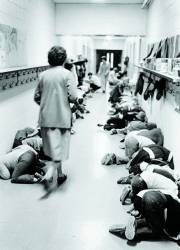I suppose I was 13 or 14 years old when my folks took me down and signed me up for the National Rifle Association hunter safety course. There we learned many useful tips, like how get through a barbed-wire fence with a loaded weapon and not to shoot at anything we couldn’t see clearly and recognize. (You know, esoteric stuff that no one teaches vice-presidents.)
I suppose I was 13 or 14 years old when my folks took me down and signed me up for the National Rifle Association hunter safety course. There we learned many useful tips, like how get through a barbed-wire fence with a loaded weapon and not to shoot at anything we couldn’t see clearly and recognize. (You know, esoteric stuff that no one teaches vice-presidents.)
All of which eventually allowed me to buy a hunting license and do more than hand my father 12-gauge shotgun shells when we were out in the orchards and asparagus patches of northeastern Oregon looking for pheasants.
Now, I’m not going to pretend I was some intrepid pioneer packing home a brace of grouse and chukars for dinner every night. No, there are few more futile feelings than watching a big cloud of pellets arcing toward the horizon as a ring-necked rooster zooms away with its distinctive crowing that, under the circumstances, sounds an awful lot like ridiculing laughter.
So, where am I going with this rustic homily?
Well, what I learned out there was, you have to lead your target. Don’t shoot at where the bird is now, but where it will be when the shot arrives.
For the past couple of years, a select portion of the GNSS community has been discussing the design of a new civil GNSS signal that would be transmitted in very similar fashion by both GPS and Galileo. This has been going on, in fact, since June 2004 when the United States and the European Union signed a historic pact for cooperation in GNSS matters.
The results of those deliberations came into the open earlier this year when the bilateral technical working group set up under the EU/US agreement issued its recommendation on what an improved common waveform should look like: a multiplexed binary offset carrier (MBOC), that would interleave an occasional BOC(6,1) waveform with the BOC(1,1) signal originally identified in the 2004 document.
Now, I won’t pretend to be even as much of an engineer as I am a marksman. But I tend to agree with the argument that we should lead GNSS technology development over the next 15 years by building MBOC into the GPS and Galileo systems.
Let me take another brief excursion down Memory Lane to explain why.
When I began my career in GNSS journalism 17 years ago, one of the first ads we published was for the Magellan NAV 1000 PRO. The unit was a single-channel, sequential tracking receiver that weighed nearly two pounds.
No moving map displays (no maps at all), no color, no voice directions, no points-of-interest database, no embedding chipsets in cell phones, PDAs, dashboards. Just lat/lon in three dimensions.
If all goes well, Galileo will have a full constellation of satellites up in five or six years. But the GPS L1C signal that would use BOC or MBOC won’t even begin launching until 2013, and many years will have to pass before the old signals are replaced.
Given those respective modernization timelines, the bilateral agreement left it up to Europe to decide — BOC or MBOC? — and the United States would follow.
Before a new civil GNSS signal comes fully on-line, multiple generations of GNSS products will have come and gone, primarily using the current and improved GPS signals now becoming available.
Manufacturers and product designers quite reasonably think in the nearer term, where features, pricing, and demand are more predictable and the bottom line is not such a mystery.
But given the past experience with GPS product development and electronics technology in general, it seems an evolution toward MBOC will allow manufacturers and GNSS receiver designers to have their cake and eat it, too.
Whichever way the decision goes, there’s no bad news here. Either signal will be an improvement over what we are using today — and that’s been plenty good, much better than believed possible in 1974.
BOC or MBOC is not a choice between good and bad. It’s a question of which is better, and which is best.





